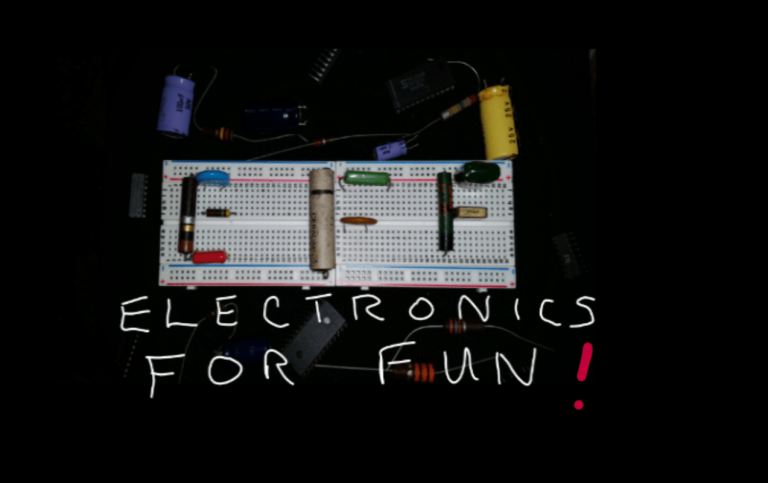Lesson 02 – Types of Electricity
The Site Menu is the ≡ in the upper right hand corner

Welcome to Electronics For Fun
Lesson 2 – Types Of Electricity
As I introduce new terms, I have included a link to Wikipedia. Read ahead a little, and if you still need help you can click on any orange word below for more information than you probably want. 🙂
Unlike the Static Electricity from the last lesson, the type of electricty that allows us to power things like our cell phones, laptops, refrigerators, and televisions, is called current electricity, and basically comes in two types.
First, there is DC which stands for Direct Current. The second type is called Alternating Current or AC. That’s the type that comes out of the outlets in our house that we plug things into like a vacuum cleaner or a TV.
Direct Current
In Direct Current, the current always flows in one direction only. A good example of something that produces Direct Current is a battery. A battery has a positive terminal and a negative terminal. There are many types and sizes of batteries from really small button batteries for hearing aids to car batteries which produce enough current to start a car!
You are probably familiar with some of these.

Those 1.5 volt batteries are everywhere, in flashlights, toys, tv remotes, etc. A lot of people just call them flashlight batteries. The most common sizes are AAA, AA, C, and D and those four types all put out the same 1.5 volts.
Why do we need so many different sizes then? The answer is because the larger ones can deliver more current, which will be explained in more detail in a future lesson. In a TV remote, on which the keys are only pressed for a moment at a time, a couple of AAA batteries, called a triple A, or some AA batteries, called a double A are fine because the circuitry in the remote doesn’t draw that much current. But in a large flashlight that might be turned on for a longer period of time and draws more current, a set of C or D cells would last longer.
One thing to note though, no matter how large or small they are, they all have a positive terminal marked with a + symbol, and a negative terminal marked with a – symbol. In almost every case, it matters which way you install them, and they won’t work if installed backwards. That’s because the current always flows in the same direction. Excess electrons, in a DC circuit, always flow out of the negative terminal, thru the circuit, and back into the positive terminal.
Most of us are familiar with the 9 volt battery. But did you know that they actually have 6 smaller 1.5 volt batteries inside?

Each one is hooked to the next one in series, + of one battery hooked to – of the next. That means they all add up. So 1.5 volts in each one times 6 = 9 volts. A future lesson will explain series (and parallel) circuits better.
There many physical sizes of batteries with different voltage outputs and varying current capacities. In addition, there are several different types of batteries based on the materials used.
The less expensive ones are not rechargeable and when they go bad you simply throw them away. Some common types are the Zinc Carbon, Alkaline and Lithium. Then there are different types of rechargable batteries such as Lead-Acid, Lithium-Ion, and Nickel Cadmium. A really nice chart can be found here.
Alternating Current
Alternating Current is very different from Direct Current. In an AC circuit, the direction that electricity flows switches back and forth very rapidly. In the United States, normal household current, which is AC, switches direction 120 times a second.
Before 1960, they used to call that 60 cycles per second, or simply 60 cycles. In 1960 they renamed it 60 hertz, to honor a German physicist named Heinrich Rudolf Hertz. He was a pioneer in the discovery of electromagnetic waves. In most other countries the standard is 50 hertz. I said that in the USA it switches 120 times a second, not 60, let me explain. It is 60 hertz, or 60 cycles. Sixty complete cycles of going in first one direction, and then the other, and then starting over. That means that even though we call it 60 hertz (cycles), it actually changes direction 120 times a second.
It isn’t like hooking up a battery and then reversing the terminals repeatedly though. The voltage does keep reversing polarity, but not all at once. From the graph below, you can see that it builds up gradually in one direction until it reaches maximum, then gradually falls back to zero volts. Next it crosses thru the zero volt line and builds up to a peak in the other direction, then back to zero volts again, and keeps repeating that pattern. That type of pattern is called a sine wave.

WARNING! HOUSEHOLD CURRENT CAN KILL YOU!
Although there are no + or – terminals in regular household current, there is somewhat of a polarity convention or agreement in the industry and they use different colored wires so the electricians can hook the wires up the same way. The black wire is considered to be the hot wire, the white wire is the neutral wire, and the bare or green wire is the ground wire. The white wires are all tied together in the circuit breaker panel where the power comes into the house. Older houses might still have fuses instead of circuit breakers. Both of them protect the wiring from getting too hot if something is shorted out. The black wires go there too but are not tied together, but instead, they go to the circuit breaker or fuse.

The wiring for a regular normally wired outlet shown here would have the black wire or wires hooked to the screws on the right side of the socket.

On the left side, the screws up top would have the white wire or wires. The screw at the bottom left would have a bare copper wire with no insulation or sometimes a green wire. If you hooked these wires up wrong, you could, depending on the situation, cause something as simple as a tripped circuit breaker or blown fuse, all the way up to a potentially lethal electric shock or a house fire. Regular household electricity is very dangerous if you don’t know what you are doing. The content in this course is teaching electronics using low, safe, voltages. Please don’t fool around with household AC.
WARNING! HOUSEHOLD CURRENT CAN KILL YOU!
In the next lesson, I’ll talk more about voltage, current, and circuits. Meanwhile, remember to stay away from household current wiring as your penalty for coming in contact with a live wire can result in anything from a mild shock, to not being able to let go, to being burned, thrown, or even killed.
Test your knowledge if you feel like it with a little test. No cheating now!
Q1: True or False….Batteries usually can be installed in either direction.
Q2: Regular household current is _______________ current.
Alternating or Direct or Neither
Q3: In the USA, household current reverses direction _______________________________.
Sixty or One Hundred Twenty or Zero

©2020 ElectronicsForFun.Com, Theme Design by Evolve Themes and Proudly Powered by WordPress